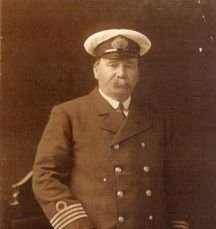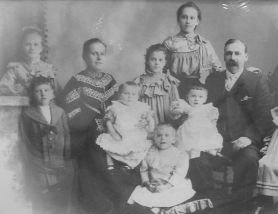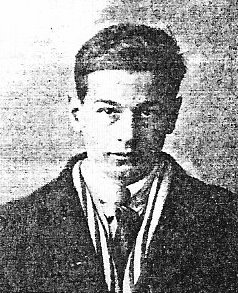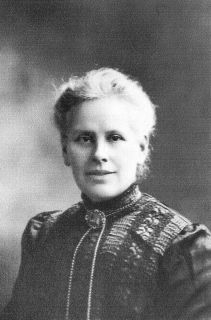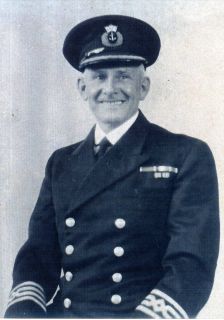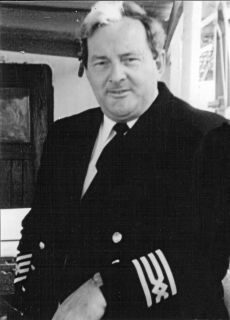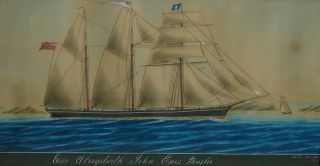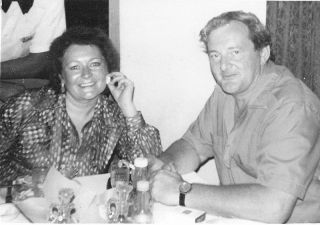CAPTAIN T.C. ENOS ELIZABETH ENOS (nee Davidson)
THE ENOS MARINERS
The Enos family can be traced back to the 1600’s living in the Tresaith area, with an Owen Enos living at Esgair Eithin Farm. James Enos 1769-1860, was the first to become a master mariner. His eldest son John 1825-1908, lived in Borth at Berlin House, renamed Break House after World War One began, married Elizabeth Jones and together they had five children. Another son Owen, b.1828, was a mariner who died in 1895, and is buried in Barry. Another son Thomas, b.1830, married Mary Morgan in 1855 and they had six children, two of whom died at sea; twenty-four year old John in 1879 whilst serving on the Snowdon, and sixty year old David James, in 1920, whilst on the Maindy Grange. A daughter Jane, b.1836, married master mariner John Davies Maesteg House.
John Enos b.1825, of Berlin House had a son James 1862-1949 who gained his masters certificate in 1889 and commanded many vessels including the barque Eos, and the steamers Glanrheidol and Knight Almoner. James’ sister Mary Jane, b. 1855, married Captain William Francis of Raglan House, who commanded the Glanrheidol, Glantivy and the Eleanor Thomas. William and Mary’s son, Idwal Owen Francis 1903-1962, also became a master mariner and worked for the Orient Line. However he decided to swallow the anchor early, and became a successful dentist in Surrey. Idwal’s two sons, Robert Owen Francis b.1945, and John Francis b.1952, both had careers at sea; Robert in the Royal Navy and John in the Merchant Navy. Another of James Enos’ sisters Margarita married Captain John Herbert and produced two sons who became master mariners, John Emlyn and Lewis James.
Captain Idwal Owen Francis
There were another three brothers who were seafarers; Captain John Enos, Glanydon House, and Captain J. Owen Enos, 1868-1938, master of the Glanystwyth, Glanhavren, Cheltonian and the Knight of Saint John. The Cheltonian was torpedoed in 1917, and J. Owen was held as prisoner of war in Germany. His brother John received a letter at Glanydon informing him that he was a prisoner of the Germans at Karlsruhe, and it also stated that he was in good health, despite having been kept on the submarine that captured him for over eighteen days. Lewis James Herbert, his nephew, was on the same vessel and landed safely in France avoiding capture. Their other brother Lewis Enos 1860-1881, died at sea on the Eos at twenty-one years of age and is buried at Malta.
Other Borth family members were the brothers James 1852-69, Thomas Charles Enos 1856-1946 and Owen Enos 1862-1943. Seventeen year old James drowned at sea on the barque Cape Wrath, Thomas became a master mariner and Owen moved to live at Barry. Thomas Charles b.1856, had a son who also became a master mariner with the same name as his father. Thomas Charles 1889-1952, was always known as Charlie, had a distinguished career for which he was awarded an O.B.E. and many service medals. He in turn had a son, Alan Charles Enos b.1932, who also became a master mariner, and is the provider of much of this information. As Alan remarks he is the fifth generation Enos originating from Borth, a fact that he is immensely proud of.
The previously mentioned Thomas Charles Enos b.1856, had a full and adventurous life. As a child he devoted much of his time trying to get out of going to school to the chagrin of his parents. However, coming from a family of mariners, it was no surprise that at the age of twelve he ran away to sea on a local schooner. For the next four years he learned the rudiments of seamanship the hard way. At sixteen years of age he joined the Sarah Ann of Cardigan, a brigantine which voyaged to the West Indies. Thomas then went on a series of full rigged ships, the Quebec and Mohur, both of Windsor Nova Scotia, and then the Borth owned barque Dora Ann. He ended up on the west coast of South America in Peru, at a time when there was a war going on between Peru and Chile. Realising that the Peruvian Navy pay was more than his then current wage, his “Cardi” spirit led him to join the Peruvian Navy. Throughout that conflict he served on the Atualpa. The countries brokered a peace and consequently Peruvian Navy life became boring.
Thomas then joined a United States shipping company, and served in several vessels, amongst which was the Vigilant, trading between the U.S.A. and the West Indies. A stint ashore followed, no doubt fuelled by the attractive wages being offered in North America. For the next three years he was rigging derricks for the building of the New York Lake Erie Railway to Buffalo. By now fifteen years had passed since he had sailed from Cardigan.
Steam ships seemed to have been his next attraction as he served for a time with the Atlas Line of New York, voyaging to the West Indies. The lure of his homeland was too much for him and he returned to Wales. His next ship was the S.S. City of Truro. He then went back to sail and joined the barquentine Emblyn of Ipswich, on a voyage to the River Plate, South America. His next vessels were the steamships Restormal and the Godmunding belonging to Cory & Sons.
By this time he was married, and no doubt his wife Elizabeth was a settling influence on him, pushing his ambitions as he soon obtained his second mates certificate. After a voyage on the Lady Clive, another Cory vessel, he was employed by Morel Ltd, and stayed with them for twenty-nine years. He voyaged on the Ferncliffe Gardappi, Laboroure, Charles W. Anderson and Wenvoe. By 1887 he gained his first command, the Beynon, followed by the Hart, Treherbert, Ninian Stuart, Portugalete, Lesreaulx and the Southerndown. The latter vessel he commanded during the First World War, running from North America to France. His next employers were Llewelyn, Merrett & Price, and he commanded the Glamorgan, Cliftonhall and the Maindy Grange. That he managed to run all those ships and produce four boys and six girls is a testament to his stamina if nothing else. He obviously lived a crammed, eventful and adventurous life to 90 years of age.
He was so highly regarded by the author “Taffrail” Captain Taprell Dorling, who wrote thirty-six books about naval life, both fictional and historical, in the first half of the twentieth century, that he was asked to check the detail contained in the novel “Mid-Atlantic”. This book has a dedication to him and reads….Captain Thomas Charles Enos who for 58 years roamed the seven seas in sailing ships and in steam tramps - to his seafaring ancestors and son I dedicate this book.
His son Thomas Charles “Charlie” 1889-1952, was highly decorated for services in both World Wars One and Two. He had a meteoric rise through the ranks that saw him as second mate in 1910, first mate in 1912 and extra master in 1915. At twenty-six years of age he was one of the youngest ever extra masters from Wales. He began live at sea as a sixteen year old on the S.S. Treherbert, and for the next five years served on the steamers Norisement, Harrovian and Cottonwood. As an officer he was on the Atlanton, Westergate, Cloughton, Empire Porpoise and the Putney Bridge before gaining his extra masters certificate. From 1922-28 he was captain of the Oakfield and from 1937-45 he commanded the Sheaf Holme.
Captain T. C. (Charlie) Enos
At the end of the war, and having garnered many awards and decorations, he thought he would retire as he was plagued with ulcers. The death of his son Brian in 1945, in a drowning accident at Langorse Lake, Brecon, had already dealt him a heavy blow. However in 1947 he was persuaded to join the Greek company Lyras & Lemos. Whilst commanding the John Lyras he supplied armaments for the Korean War. His maritime career ended when he was flown home from Kobi in Japan after becoming ill in 1952. Charlie had successfully avoided the enemy in two world wars and the conflict on the Korean Peninsula, which was as much down to luck as his skilled seamanship. What makes his story even more remarkable is the fact that he had spent ten years ashore in the 1930’s trying to make a living from several business ventures, including a fish and chip shop. As his son Alan states, “there are few shore jobs for a ships captain” and he is convinced that it all caught up with his father who died at the age of sixty-three in 1952.
On one memorable voyage Charlie had a very sick crew-member to deal with. After consulting the medical books he realised to his horror that the crewman had appendicitis. This meant an immediate operation in mid-ocean or death. Communications were only possible via Morse code, so Charlie decided to operate with the limited surgical knives in the first aid kit. After a hazardous couple of hours with the instructions being relayed to him via the radio officer, the primitive procedure was completed. Much to everyone’s relief the patient made a full recovery with the captain, according to his son Alan, praying to God it would never happen again.
Another incident happened in 1919 when Charlie’s ship was loading grain at a Black Sea port. The interpreter for the Russian Government agents, always accompanied by an armed guard, who liaised with the captain had been a mill owner prior to the communist government taking over. On the first day having finished discussing cargo details, the interpreter made an unusual request. He explained to the young captain that his wife and children had escaped from Russia and now lived in Belgium. As he probably would never see them again could the captain do him a great service? As the accompanying Russian guard did not understand English he went on to elaborate by stating that he would leave a small parcel the following day that contained a trove of family jewellery that the Russian authorities were unaware of. Charlie agreed to be entrusted with taking them to Europe, having them valued selling them and ensuring that the proceeds reached his family. Charlie kept his side of the bargain. The Welshman and the Russian only met once and Charlie often wondered what fate befell the parties concerned.
Another odd incident occurred in 1940 when Charlie was in Alexandria in command of the Sheaf Holme. He was ordered to voyage to Liverpool by the long route via the Cape of Good Hope after accommodating an English “ornithologist“, Peter Cheesborough. The captain got on very well with the new passenger during the trip home and they exchanged addresses after arriving safely at Liverpool. In 1946 a letter arrived from Peter Cheeseborough explaining that he had actually been on a spying mission on the Turkish/Russian border, and not bird watching in Egypt. It was not so much this revelation but the strange sequel twenty years after Charlie’s death. In 1972 Charlie’s son Alan and his wife Valerie were visiting a friend at Magor South Wales. During this time Valerie got to know the next door neighbour who was a garage owner, and in a conversation he stated that he was going on a trip to London to see his girlfriend who lived with her mother. Apparently the mother was courting a man called Peter Cheeseborough, Valerie related this fact to her husband as she was familiar with the spy story. Whilst both thought it was coincidental, they were still curious and asked if the garage owner would ask this Peter Cheesborough a few questions and mention the name Captain Enos. Sure enough it was the spy Peter Cheeseborough, who by then was in his seventies was working as a janitor in a block of flats…he even sent a letter confirming this. As Captain Alan Enos stated “is this the occupation spies end up doing”?
Captain T. C. Enos’ son Alan b. 1932, went to sea in 1950 where four years later he became second mate. Then almost like a repeat of his father’s career, he stayed ashore for nearly two decades employed as a representative of companies such as Avery Scales and Esso Petroleum, intermittently running a fruit shop and an antiques gallery. He returned to sea in 1973 and soon became first mate and gained his masters in 1978 whilst he was first officer on the Viterwyck. A year later he was in command of the Playas. He commanded the Deseado, Brittany, Loch Fyne, Highland Princess, Potaro, Geest Star, Geest Bay, Geest Crest and Geest Cape.
Alan recalls when he was third mate on the Beresina under the taciturn Captain Williams of Amlwch, who rarely communicated with anyone except the first mate. One day a crew-member reported in sick with severe stomach cramps. The bosun was convinced that he was swinging the lead as he was a persistent malingerer. It got to the point where the captain had to administer medical assistance. This consisted of “binding” him up, then dosing him with “opening” medicine, all to no avail. The captain had by then come to the same conclusion as the bosun about the crewman and his dubious stomach ailment. Surprisingly he took Alan with him to visit the patient and declared that he was at his wits end and that a strong remedy was going to be the last resort. Well within the patients hearing the captain, with a slight wink at Alan, told him to organise ingredients and instruments for the “bosphotic” treatment. Totally mystified Alan enquired what he had to source and how did it work? The captain said that he wanted several egg whites from the galley and that Alan should go to his cabin to fetch a bicycle pump that he purported to keep there. After these arrived crew-members were to be summoned to hold the patient down, and that the egg whites would be blown up the crewman’s backside with the bicycle pump. The captain followed Alan out of the patient’s cabin and tersely stated “let’s wait a while”. A few hours later the bosun reported that the “sick” crew-member was back at work with a dedication not witnessed before.
On a more serious note, Alan remembers loading a mixed cargo in the U.S.A. that was bound for North Africa. There were many drums of chemicals on one level and above them several very heavy compressors. After being assured several times by the first mate that the cargo, especially the compressors, were lashed in place, the Laurie U left New Orleans. In mid-Atlantic they encountered a severe gale with huge rolling seas. It was difficult to keep the vessel steady without the bad news that was bought to the bridge by the bosun. He reported that there was an awful smell coming from No. 2 hatch. Alan ordered the vessel to slow down as he made an inspection. His worst fears were realised as the generators were loose and had with the ships’ motion, sawn off the tops of the chemical containers. The fumes were quite toxic and Alan went to check what was in the containers. It turned out they were not those labelled on the drums, and were in fact if anything, more toxic and volatile. Alan immediately ordered the bosun to assemble the crew, search them and their cabins, to confiscate cigarette lighters and electrical implements and anything that could cause a spark. The vessel was turned into the sea to bring about as much stability as possible in the conditions. It was a very tense situation as for hours the air was full of chemical fumes and there was a fear that any minute there could be an explosion resulting in a total loss of life and the ship sinking without trace. Adding to Alan’s dilemma was the fact that his wife was also on board, and as he relates there were moments when he thought that this would be the end. Thankfully the sea became calmer and he radioed to instruct the owners that he was jettisoning the lethal chemical cargo which was endangering the ship. All vessels in the area were alerted of the dumping of part of the cargo. The compressors were then re-secured and they continued their voyage carefully. Alan sent a supply of beer to the bosun and the crew to thank them for their skill and care in a perilous situation.
Alan dreaded having the responsibility as captain for any medical emergency which dealt with surgery after hearing his fathers surgical tale. However it was inevitable that one day the moment he feared would arrive. A crew-member had nearly lost his finger whilst working on a wire rope. It was obvious that either the remaining skin would be cut and the finger removed, or it had to be stitched together. Alan, only an occasional beer drinker, decided that he and the patient should have a couple of large whiskies before operating; after deciding to try and save the finger. Carefully following the medical manual the procedure was finished an hour or so later. Miraculously it proved highly successful and he was praised by a surgeon at the next port in the Azores who checked out his handy work. Apparently the nerves and tendons were working smoothly. Alan retired from the sea and with his wife, ran a home for the elderly for a number years in Barry. He currently lives near Wantage and maintains an interest in one of his great loves, antique clocks.
Again it seems that Borth was the catalyst for most of the sixteen mariners in this family, and it is the one vessel, the barque Eos that seems to have been pivotal. The Enos seafarers of Borth constituted the nucleus of the crew of this Aberystwyth vessel, which was trading further afield than British waters and often voyaged to South America to places such as Rio Grande de Sul in Brazil.
The Eos was originally owned by Thomas H. Jones of Aberystwyth, and captained by his brother Samuel Jones. Four of the Enos boys, John, Lewis, James and Owen, were on her constantly as crewmembers with John as first mate. Finally in 1884, after gaining his masters certificate, John Enos bought and ran this ship. It became a training vessel for a generation of Enos masters who went on to command steamers. The Eos was wrecked, as were several other vessels, when navigation aids had moved, or been misplaced, in Safi Bay Morocco. Captain Jenkins of Borth, who was master of the Eos during this last voyage, was bought back with his crew and others from several wrecks, to Britain on the Tasmania. From humble, yet enterprising beginnings, at a small village, the Enos family became involved with shipping at Aberystwyth, Barry and Cardiff, where many of their descendants now live and continue the seafaring tradition.
